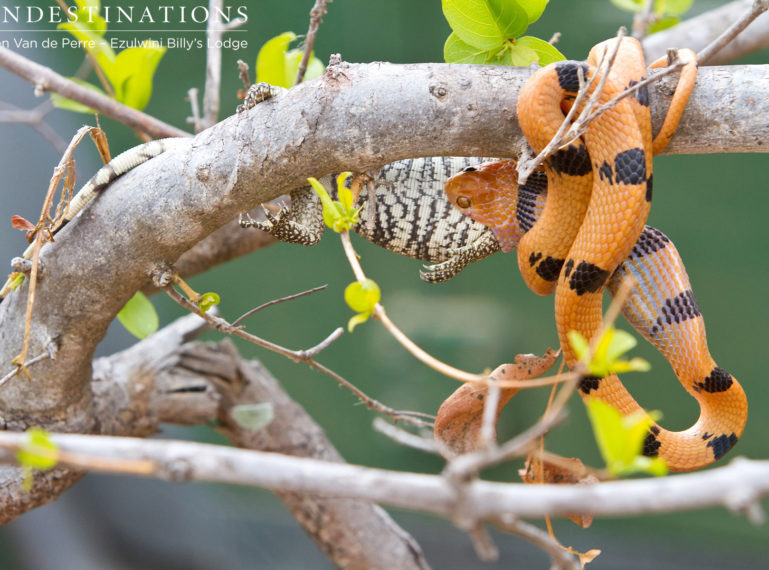
Snakes, crocodiles, skinks, and lizards are somewhat less admired than say, leopards and lilac-breasted rollers, but just because they don’t have beautiful plumes and velvety pelts doesn’t mean that they aren’t worth watching! What you probably didn’t know is that crocodiles are more closely related to birds than they are to lizards. The history of reptiles is ancient, dating back hundreds of millions of years, when snakes descended from 4-legged creatures, and turtles looked relatively the same!
Ezulwini Game Lodges, located in the diverse Balule Nature Reserve, enjoy numerous reptile sightings, particularly crocodiles, which are often seen basking on the banks of the Olifants River. These giant, scaly creatures are feared for their vicious teeth and vice grip they place on their prey. They lie in wait of the perfect opportunity to pounce, which is an incredibly quick movement, leaving little room for escape. Ezulwini guests see these Nile crocodiles soaking up the sun along the river with their jaws open and yellow inner-mouths on display as they absorb the sun’s warmth to moderate their body temperature.
Rock monitors, also known as legavaans, are large lizards with dangerously strong tails, which they use for defence. They are the second longest lizard found in Africa and have the heaviest bodies, weighing up to 8kg. They have a widely varied diet, preferring to snatch up whatever they can find, and often! Rodents, birds, small mammals, other lizards, fish, tortoises, eggs, and even carrion are on the menu for this ferocious reptile.
Beauty comes in all shapes and sizes, scales, and skin types. Case in point, the Eastern tiger snake. This was a fantastic sighting of this small, beautifully patterned snake, which is usually found on the ground and active at night. We bumped into the gorgeous reptile slung around the branches of a tree, in broad daylight, feasting on a large lizard, possibly a small river monitor. This was an incredible sight of reptile-on-reptile predation, and we are lucky to have seen it.
Also on the snake front, we found one of the most venomous snakes in South Africa: the boomslang. Often depicted as bright green (these are the males), it was interesting to see the female boomslang, which has a less exotic brown colouration. Boomslang directly translated from Afrikaans means ‘tree snake’, which is a perfect description of this snake’s habitat and behaviour. True to form, we saw the boomslang entangled in the branches of a tree. Boomslangs are easily identified by their large, geometric scales, and big, round eyes.
One of the more rarely seen lizards is the blushing giant plated lizard. The male has incredible red colouration on his throat during breeding season while non-breeding males have a paler throat. These reptiles have a largely vegetarian diet, ranging from flowers, and leaves to soft fruit from trees, bout they have also been known to prey on smaller lizards. Extra protein!
A common resident around both Billy’s Lodge and River Lodge is the striped skink. Visitors to Kruger will recognise this slender, smooth and shiny member of the lizard family by its dark brown form, streaked with 2 pale yellow vertical stripes. There is no definitive neck to the skink’s body shape, and it is often seen raising itself up on its front legs, while its back legs stay flat on the surface it is resting on. It eats insects and beetles, burrowing into shady crevasses of rocks and wooden structures. Anything that eats mosquitos can stay!








Leave a Comment